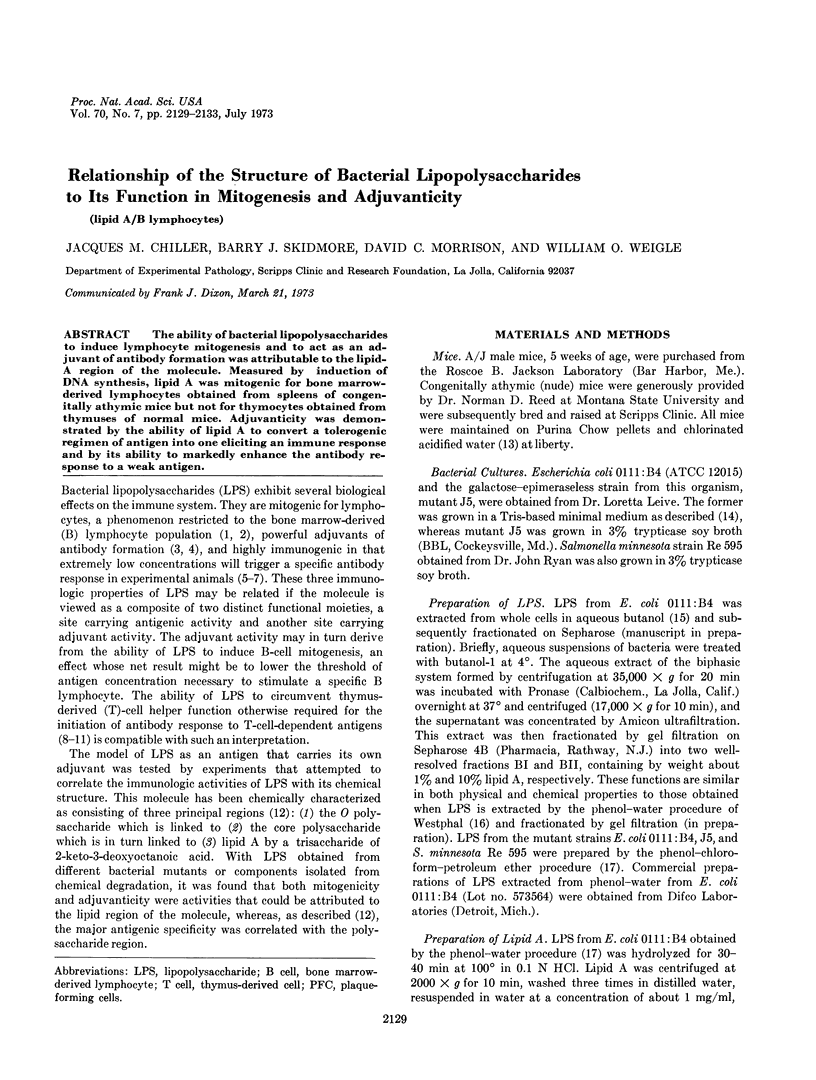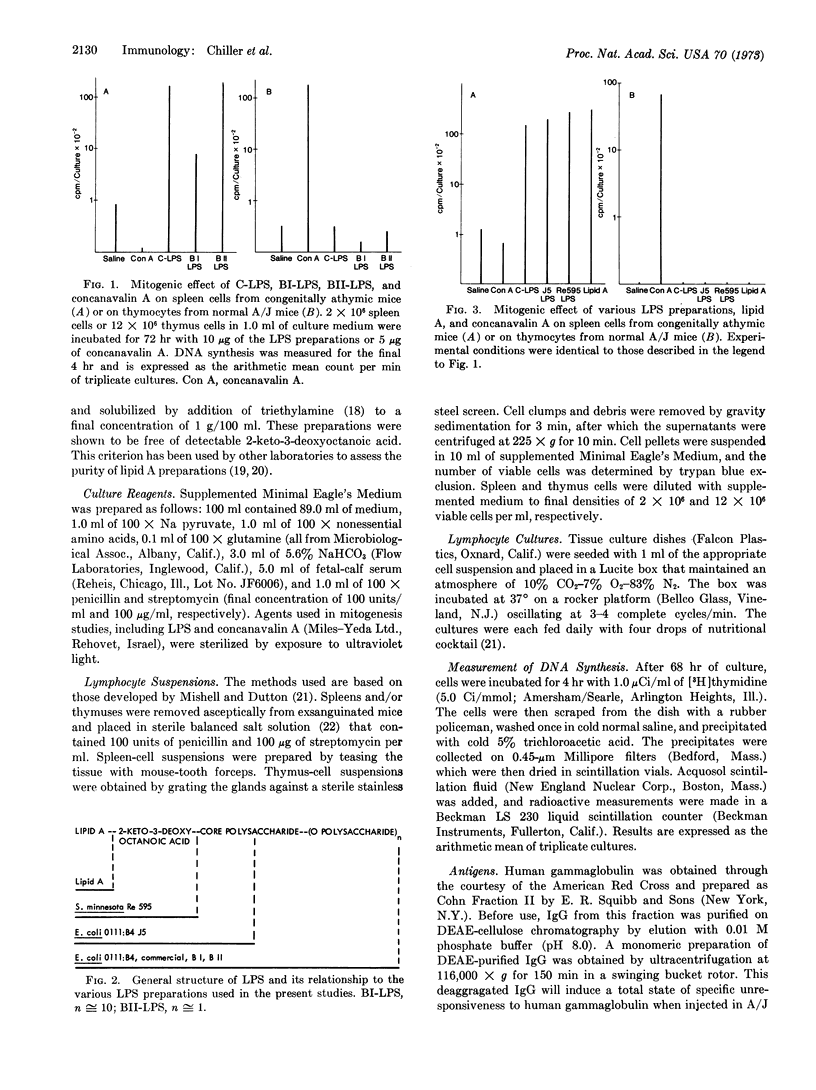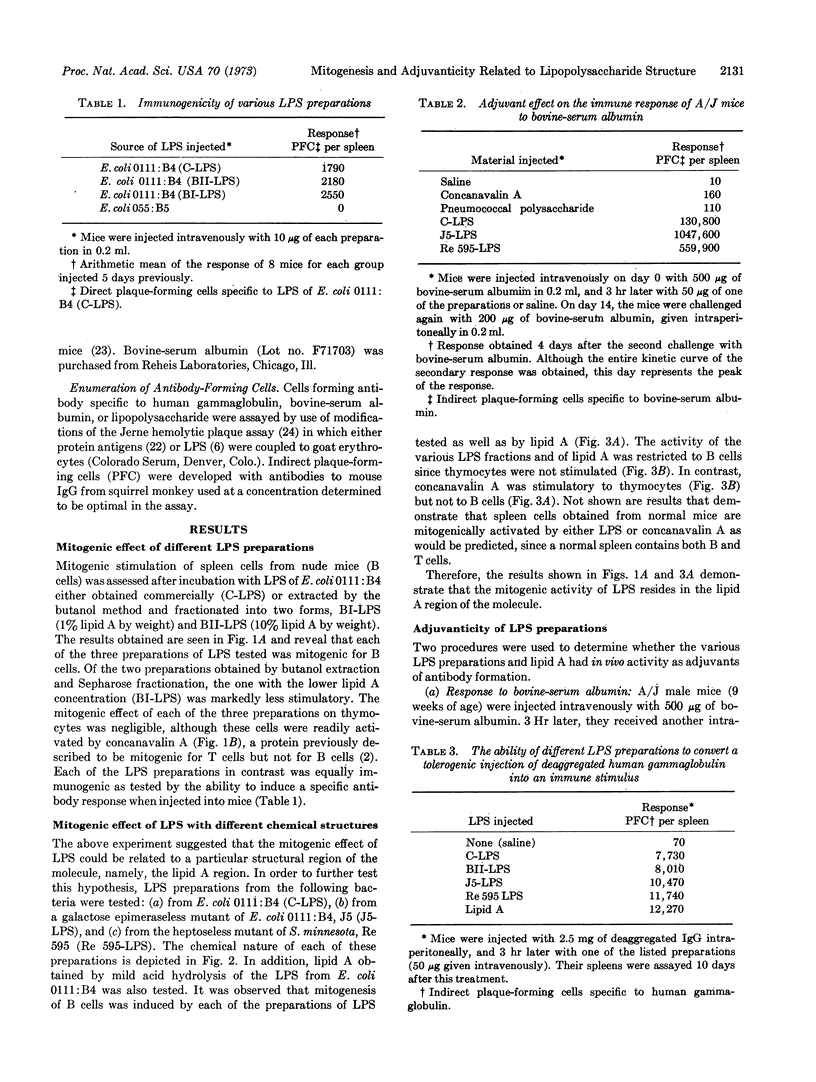Abstract
The ability of bacterial lipopolysaccharides to induce lymphocyte mitogenesis and to act as an adjuvant of antibody formation was attributable to the lipid-A region of the molecule. Measured by induction of DNA synthesis, lipid A was mitogenic for bone marrow-derived lymphocytes obtained from spleens of congenitally athymic mice but not for thymocytes obtained from thymuses of normal mice. Adjuvanticity was demonstrated by the ability of lipid A to convert a tolerogenic regimen of antigen into one eliciting an immune response and by its ability to markedly enhance the antibody response to a weak antigen.
Keywords: lipid A, B lymphocytes
Full text
PDF




Selected References
These references are in PubMed. This may not be the complete list of references from this article.
- Alexander P., Evans R. Endotoxin and double stranded RNA render macrophages cytotoxic. Nat New Biol. 1971 Jul 21;232(29):76–78. doi: 10.1038/newbio232076a0. [DOI] [PubMed] [Google Scholar]
- Andersson J., Möller G., Sjöberg O. Selective induction of DNA synthesis in T and B lymphocytes. Cell Immunol. 1972 Aug;4(4):381–393. doi: 10.1016/0008-8749(72)90040-8. [DOI] [PubMed] [Google Scholar]
- BARRIE J. U., COOPER G. N. ENHANCEMENT OF THE PRIMARY ANTIBODY RESPONSE TO PARTICULATE ANTIGENS BY SIMPLE LIPIDS. J Immunol. 1964 Apr;92:529–539. [PubMed] [Google Scholar]
- Braun W., Nakano M. Antibody formation: stimulation by polyadenylic and polycytidylic acids. Science. 1967 Aug 18;157(3790):819–821. doi: 10.1126/science.157.3790.819. [DOI] [PubMed] [Google Scholar]
- Chiller J. M., Weigle W. O. Cellular events during induction of immunologic unresponsiveness in adult mice. J Immunol. 1971 Jun;106(6):1647–1653. [PubMed] [Google Scholar]
- Chiller J. M., Weigle W. O. Termination of tolerance to human gamma globulin in mice by antigen and bacterial lipopolysaccharide (endotoxin). J Exp Med. 1973 Mar 1;137(3):740–750. doi: 10.1084/jem.137.3.740. [DOI] [PMC free article] [PubMed] [Google Scholar]
- DRESSER D. W. Effectiveness of lipid and lipidophilic substances as adjuvants. Nature. 1961 Sep 16;191:1169–1171. doi: 10.1038/1911169a0. [DOI] [PubMed] [Google Scholar]
- Galanos C., Lüderitz O., Westphal O. A new method for the extraction of R lipopolysaccharides. Eur J Biochem. 1969 Jun;9(2):245–249. doi: 10.1111/j.1432-1033.1969.tb00601.x. [DOI] [PubMed] [Google Scholar]
- Galanos C., Lüderitz O., Westphal O. Preparation and properties of antisera against the lipid-A component of bacterial lipopolysaccharides. Eur J Biochem. 1971 Dec 22;24(1):116–122. doi: 10.1111/j.1432-1033.1971.tb19661.x. [DOI] [PubMed] [Google Scholar]
- Galanos C., Rietschel E. T., Lüderitz O., Westphal O., Kim Y. B., Watson D. W. Biological activities of lipid A complexed with bovine-serum albumin. Eur J Biochem. 1972 Dec 4;31(2):230–233. doi: 10.1111/j.1432-1033.1972.tb02524.x. [DOI] [PubMed] [Google Scholar]
- Gall D. The adjuvant activity of aliphatic nitrogenous bases. Immunology. 1966 Oct;11(4):369–386. [PMC free article] [PubMed] [Google Scholar]
- Gery I., Krüger J., Spiesel S. Z. Stimulation of B-lymphocytes by endotoxin. Reactions of thymus-deprived mice and karyotypic analysis of dividing cells in mice bearing T 6 T 6 thymus grafts. J Immunol. 1972 Apr;108(4):1088–1091. [PubMed] [Google Scholar]
- Golub E. S., Mishell R. I., Weigle W. O., Dutton R. W. A modification of the hemolytic plaque assay for use with protein antigens. J Immunol. 1968 Jan;100(1):133–137. [PubMed] [Google Scholar]
- JERNE N. K., NORDIN A. A. Plaque formation in agar by single antibody-producing cells. Science. 1963 Apr 26;140(3565):405–405. [PubMed] [Google Scholar]
- JOHNSON A. G., GAINES S., LANDY M. Studies on the O antigen of Salmonella typhosa. V. Enhancement of antibody response to protein antigens by the purified lipopolysaccharide. J Exp Med. 1956 Feb 1;103(2):225–246. doi: 10.1084/jem.103.2.225. [DOI] [PMC free article] [PubMed] [Google Scholar]
- Jones J. M., Kind P. D. Enhancing effect of bacterial endotoxins on bone marrow cells in the immune response to SRBC. J Immunol. 1972 May;108(5):1453–1455. [PubMed] [Google Scholar]
- LEIVE L. ACTINOMYCIN SENSITIVITY IN ESCHERICHIA COLI PRODUCED BY EDTA. Biochem Biophys Res Commun. 1965 Jan 4;18:13–17. doi: 10.1016/0006-291x(65)90874-0. [DOI] [PubMed] [Google Scholar]
- Landy M., Baker P. J. Cytodynamics of the distinctive immune response produced in regional lymph nodes by Salmonella somatic polysaccharide. J Immunol. 1966 Nov;97(5):670–679. [PubMed] [Google Scholar]
- Mishell R. I., Dutton R. W. Immunization of dissociated spleen cell cultures from normal mice. J Exp Med. 1967 Sep 1;126(3):423–442. doi: 10.1084/jem.126.3.423. [DOI] [PMC free article] [PubMed] [Google Scholar]
- Möller G. Immunocyte triggering. Cell Immunol. 1970 Dec;1(6):573–582. doi: 10.1016/0008-8749(70)90023-7. [DOI] [PubMed] [Google Scholar]
- Rietschel E. T., Gottert H., Lüderitz O., Westphal O. Nature and linkages of the fatty acids present in the lipid-A component of Salmonella lipopolysaccharides. Eur J Biochem. 1972 Jul 13;28(2):166–173. doi: 10.1111/j.1432-1033.1972.tb01899.x. [DOI] [PubMed] [Google Scholar]
- Rothfield L., Romeo D. Role of lipids in the biosynthesis of the bacterial cell envelope. Bacteriol Rev. 1971 Mar;35(1):14–38. doi: 10.1128/br.35.1.14-38.1971. [DOI] [PMC free article] [PubMed] [Google Scholar]
- Rudbach J. A. Molecular immunogenicity of bacterial lipopolysaccharide antigens: establishing a quantitative system. J Immunol. 1971 Apr;106(4):993–1001. [PubMed] [Google Scholar]
- Schmidtke J. R., Dixon F. J. Immune response to a hapten coupled to a nonimmunogenic carrier. Influence of lipopolysaccharide. J Exp Med. 1972 Aug 1;136(2):392–397. doi: 10.1084/jem.136.2.392. [DOI] [PMC free article] [PubMed] [Google Scholar]
- Sjöberg O., Andersson J., Möller G. Lipopolysaccharide can substitute for helper cells in the antibody response in vitro. Eur J Immunol. 1972 Aug;2(4):326–331. doi: 10.1002/eji.1830020406. [DOI] [PubMed] [Google Scholar]
- Springer G. F., Huprikar S. V., Neter E. Specific inhibition of endotoxin coating of red cells by a human erythrocyte membrane component. Infect Immun. 1970 Jan;1(1):98–108. doi: 10.1128/iai.1.1.98-108.1970. [DOI] [PMC free article] [PubMed] [Google Scholar]
- Stobo J. D., Rosenthal A. S., Paul W. E. Functional heterogeneity of murine lymphoid cells. I. Responsiveness to and surface binding of concanavalin A and phytohemagglutinin. J Immunol. 1972 Jan;108(1):1–17. [PubMed] [Google Scholar]
- Uhr J. W., Möller G. Regulatory effect of antibody on the immune response. Adv Immunol. 1968;8:81–127. doi: 10.1016/s0065-2776(08)60465-4. [DOI] [PubMed] [Google Scholar]


